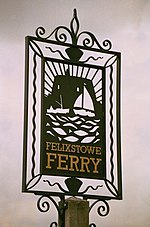Walton Castle, Suffolk
All accuracy disputesArchaeological sites in SuffolkCastles in SuffolkEngvarB from July 2017Felixstowe ... and 1 more
Saxon Shore forts

Walton Castle was a Saxon Shore Fort in the Roman province of Britannia. The fort was reused by the Normans who used it as the bailey for a castle. It stood 30 metres above sea level but was destroyed by coastal erosion in the 18th century. It was located in the village of Walton, Suffolk, now part of Felixstowe (grid reference TM32253580).
Excerpt from the Wikipedia article Walton Castle, Suffolk (License: CC BY-SA 3.0, Authors, Images).Walton Castle, Suffolk
Cliff Road, East Suffolk Old Felixstowe
Geographical coordinates (GPS) Address Nearby Places Show on map
Geographical coordinates (GPS)
| Latitude | Longitude |
|---|---|
| N 51.972166666667 ° | E 1.3800277777778 ° |
Address
Cliff Road
IP11 9SQ East Suffolk, Old Felixstowe
England, United Kingdom
Open on Google Maps







